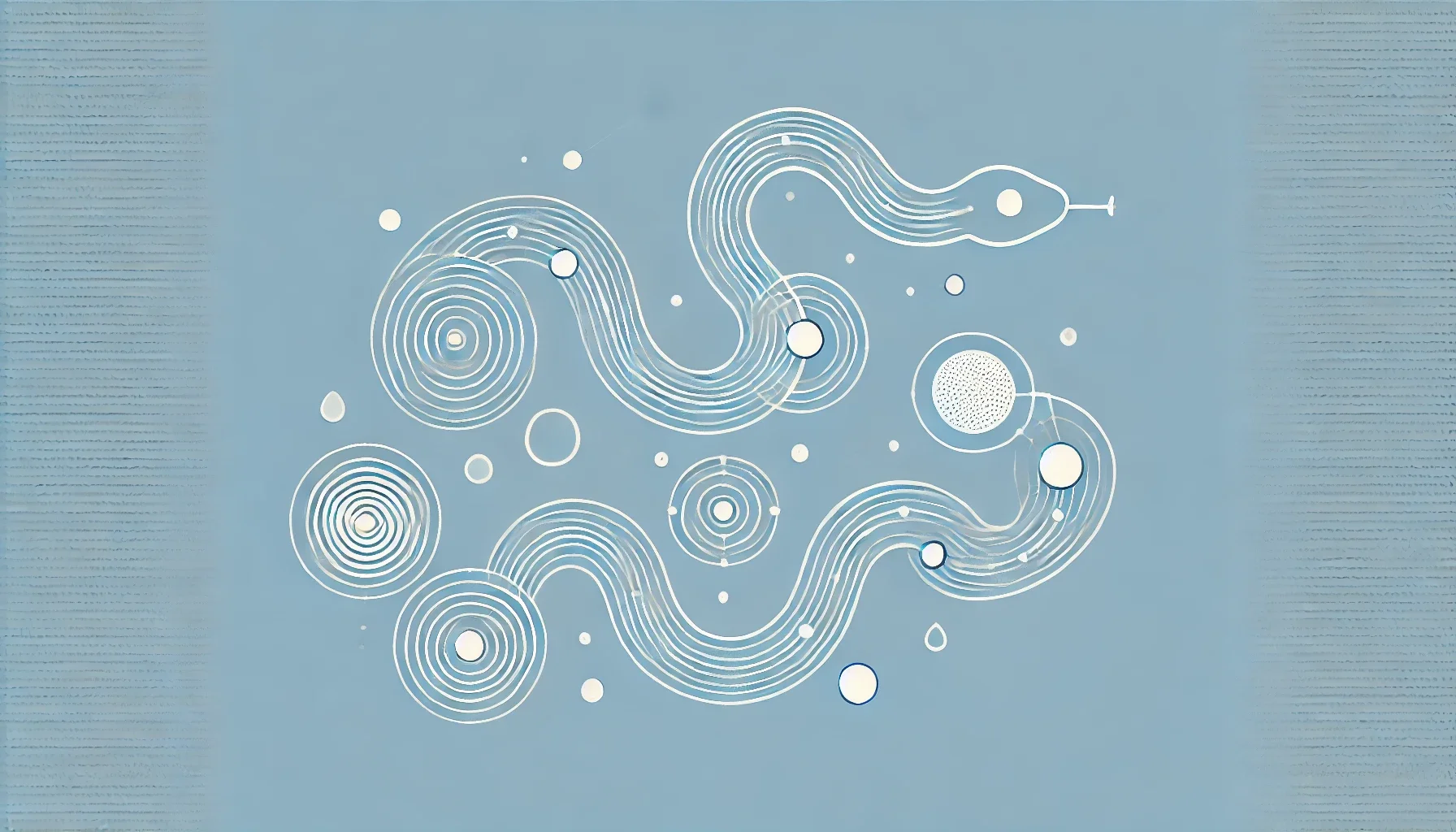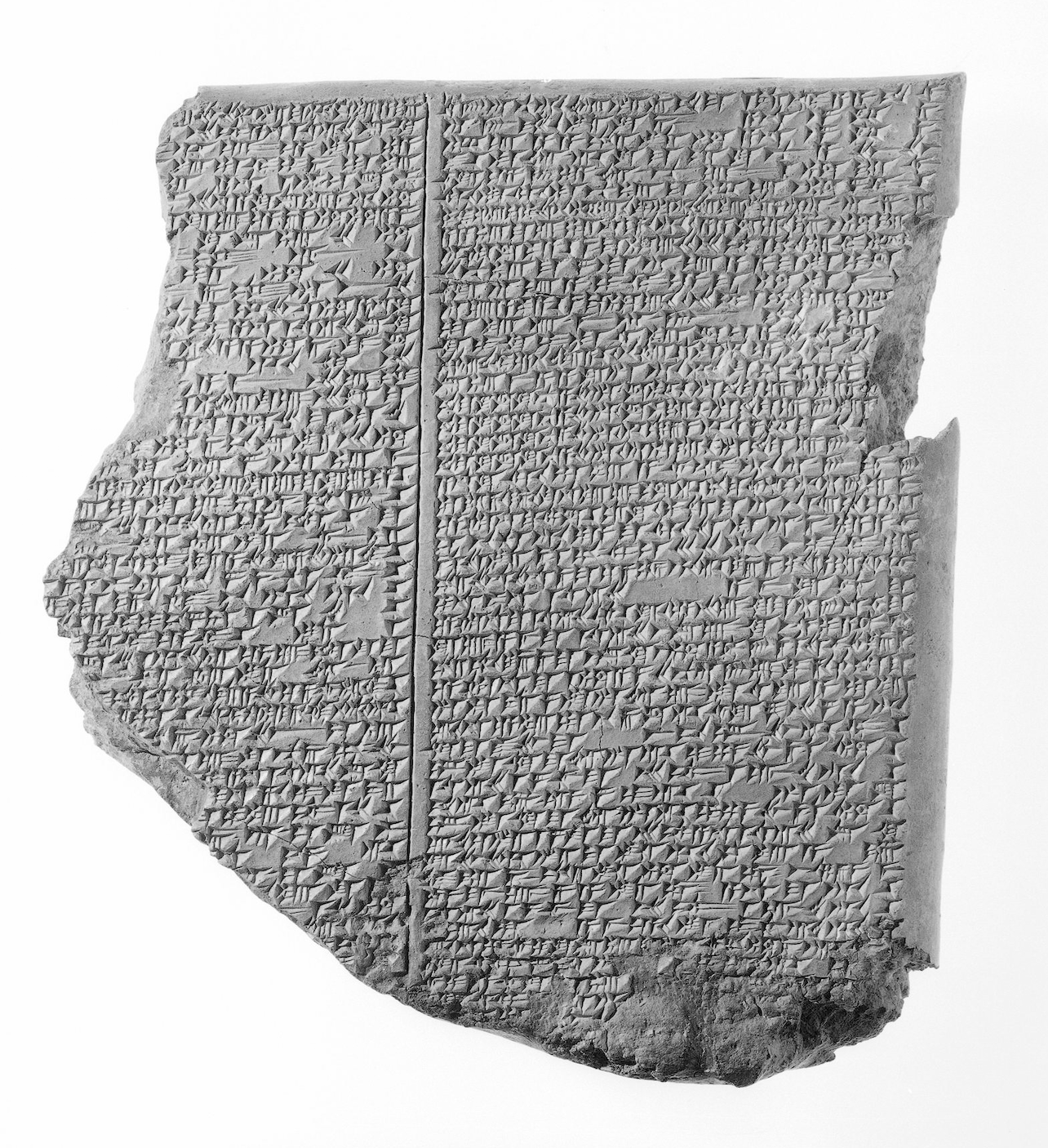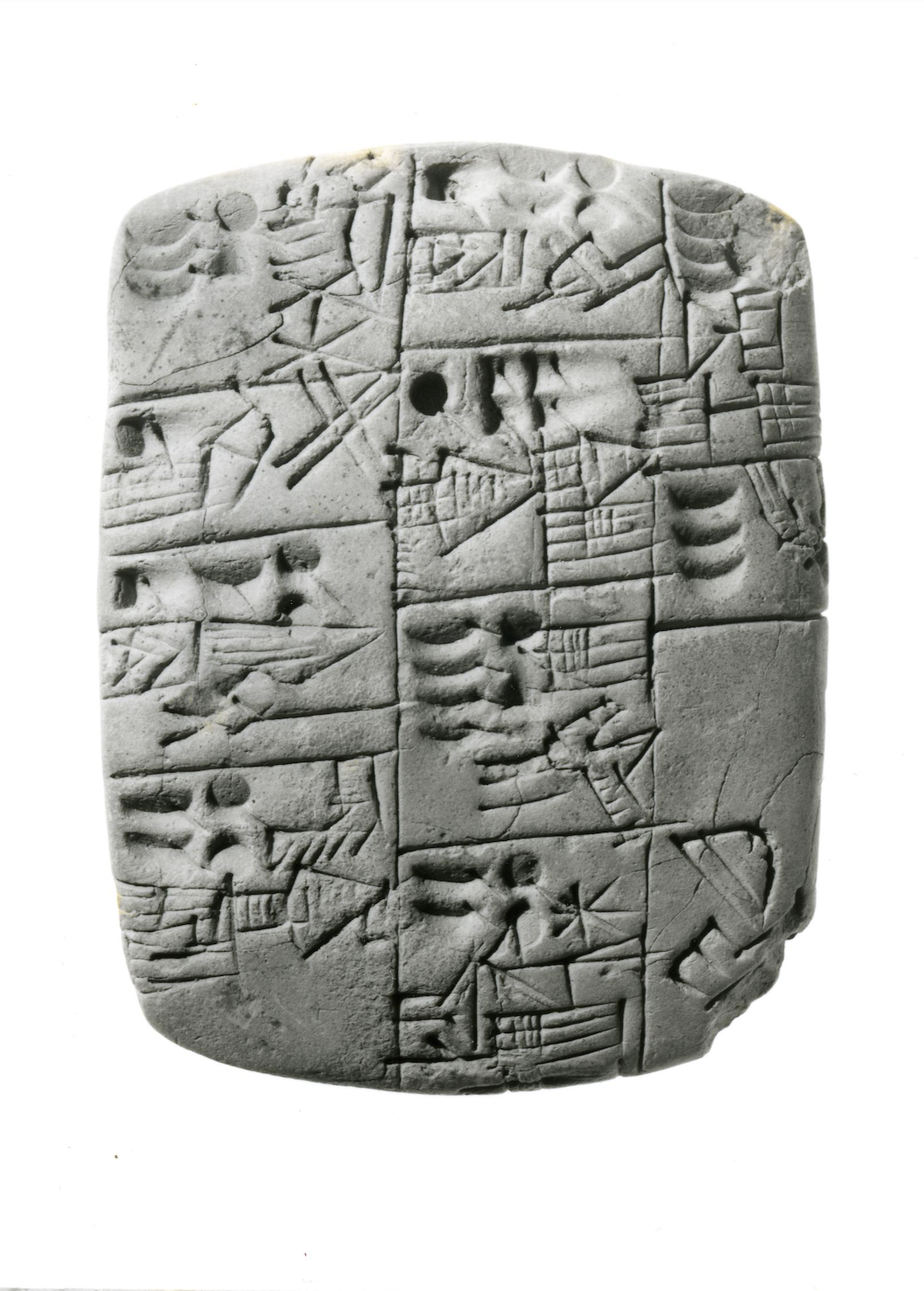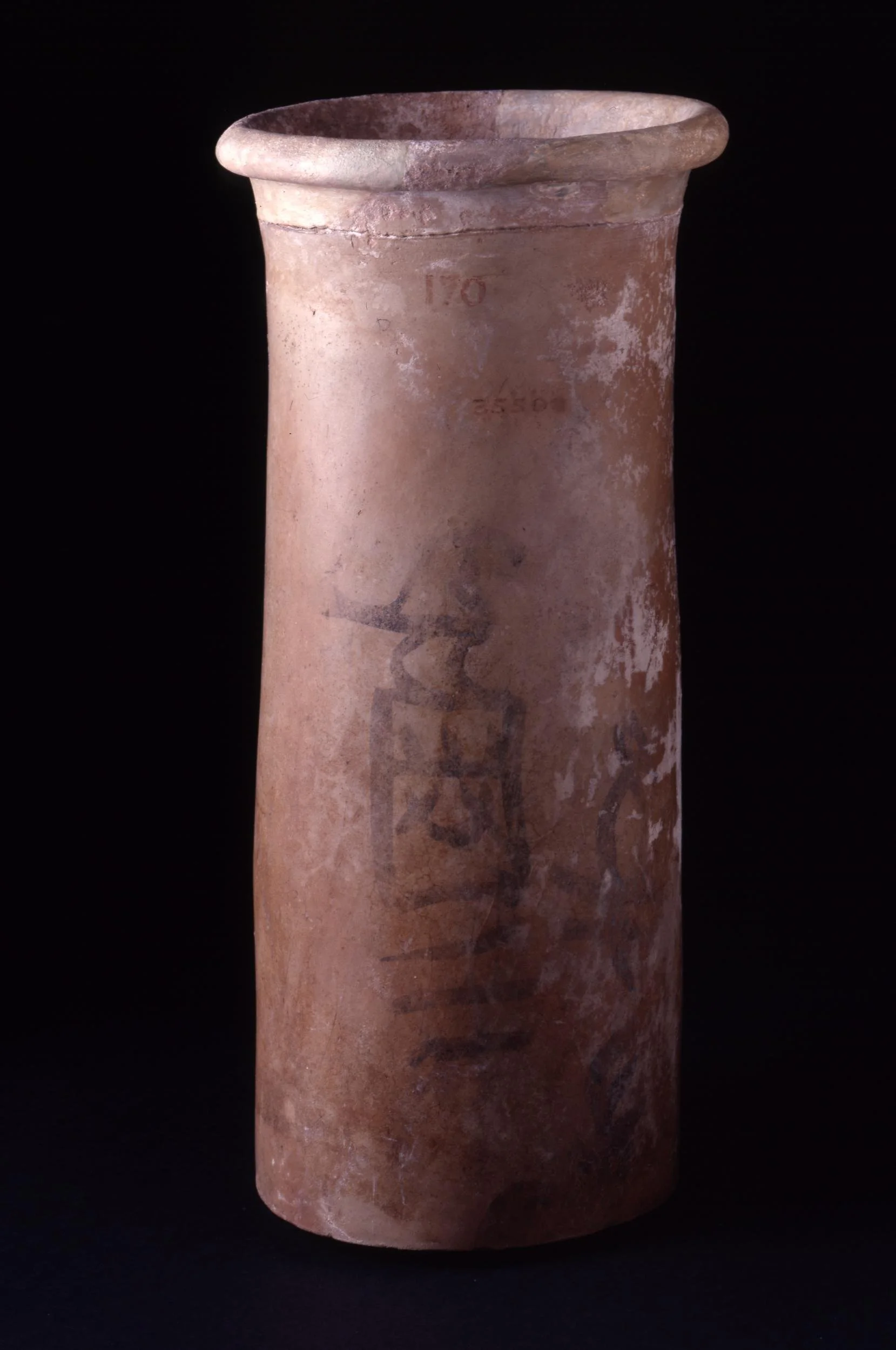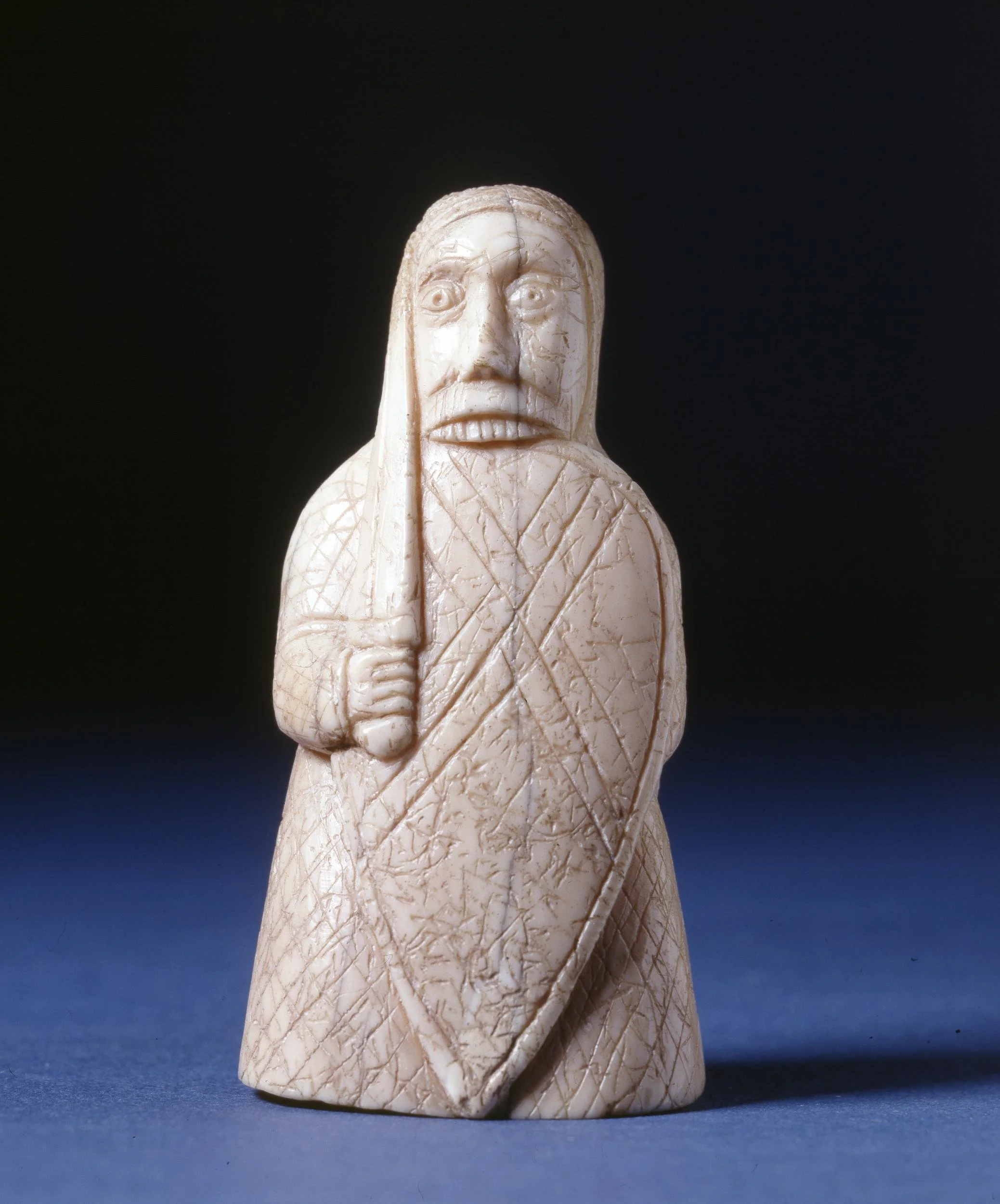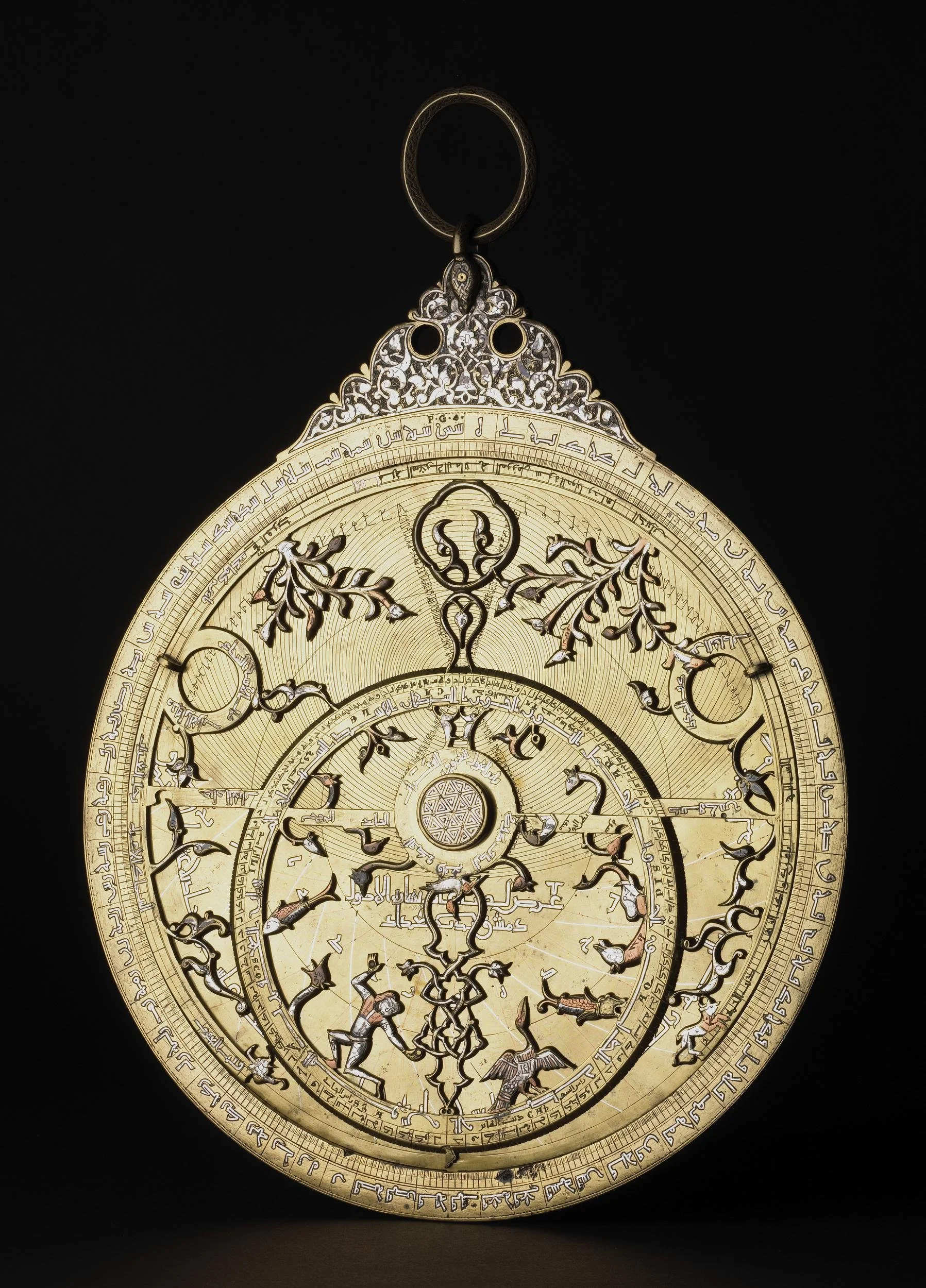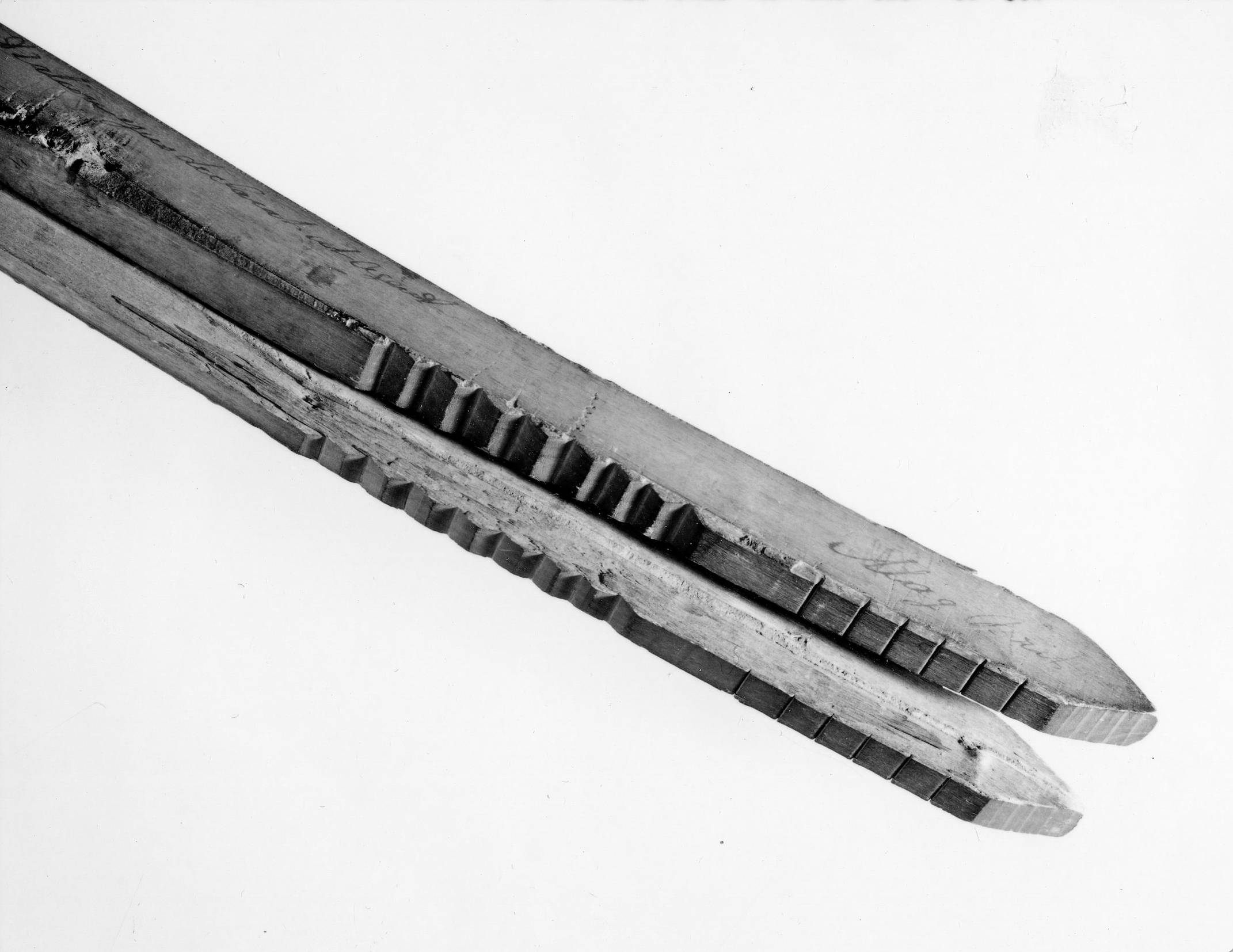Some of the stories I wrote started with these Museum objects — and here, I tell them in my own voice.
Songline paintingTranscript
Let’s step into Room 24 together. Do you see that purple painting in the middle? At first — you might just walk past it. Honestly, I did too. At a glance, it’s hard to tell what it is.
Take a closer look — you’ll see four black snakes, surrounded by clusters of black and white dots, scattered across the canvas. Now turn to the back wall — there’s another painting with a green background. Lots of circles, big and small, all linked together with red lines.
These two works were painted in 2013 by artists from the Spinifex people, who live in the remote desert of Western Australia. They’ve taken an ancient song, passed down through generations — and turned it into a painting.
These songs are called Songlines in English, or Dreaming Tracks in Aboriginal languages. Aboriginal Australians believe that, long ago, their ancestors shaped the land. This time is known as the Dreamtime, or simply the Dreaming. Their ancestors appeared as people or animals and travelled across the land. And those movements became the land itself — rivers, rocks, and springs.
These stories were passed down through song — and that’s what a Songline is. If you follow the song, you follow a path. It’s almost like a code — one line might say, “Behind the big rock, the snake turned left.” And that one line of song tells you where to change direction. It’s a song — but also a map. The paintings you’re seeing now show these Songlines, with dots, lines, and colours.
The green painting shows a place called Kuru Ala. There’s a story here — about seven sisters fleeing from a man who kept chasing them. They finally escape, and rise up into the sky, becoming stars.
This is based on a real landscape. The story was inspired by a hidden cave in a rocky mountain out in the desert — the place where the sisters hid from the man who kept chasing them, a stalker-like figure in the story. (There are also lots of hollowed-out areas nearby, and the whole place has a unique shape.)
Try comparing the painting with the aerial photo next to it. You’ll see how the dots in the painting match the actual rocks and cliffs in the landscape.
The red painting shows a place called Pukara. There’s a Songline here about ancestral beings who turned into water snakes. As they crossed hundreds of kilometres of desert, they left behind rock pools. When it rains in the desert, these pools fill with water — precious drinking water. That’s probably why the Aboriginal people kept track of them — in song.
Even today, Aboriginal communities sing these songs, and keep the memories alive through painting and carving. Because these aren’t just paintings — they are living maps.
BENIN crown© The Trustees of the British Museum
Transcript
Let’s head into Room 25. Here you’ll find objects from West Africa, from a kingdom called Benin. The Benin Kingdom lasted for about 400 years, from the 1400s to the 1800s, in what’s now southern Nigeria. For all that time, the country was ruled by a king.
And here’s something unique — they didn’t use writing. So you’ll see exactly how they recorded history without words. First, look for the red coral crown. It looks like a hat, but it’s actually a real crown. In Benin, the king was called an Oba, and the Oba always wore this coral crown. When we think of crowns, we usually picture gold and jewels, right?
But in Benin, coral was the most precious material. So the king wore a coral crown, and decorated himself with coral jewellery. But coral is actually pretty heavy. On special occasions, the Oba would wear an even bigger, more elaborate coral crown — so heavy that he couldn’t take it off by himself. Even with that discomfort, he wore it to show his power and authority.
Now look at the glass case in front of the crown. You’ll see bronze busts of past kings. When a king died, they made a bronze like this to remember him. And on each sculpture’s head, you can see the coral crown again.
On the wall, you’ll see bronze plaques called the Benin Bronzes. These were once attached to the pillars of the royal palace — and they show portraits of kings and their attendants.
You can spot the king wearing the coral crown, and scenes with leopards carved beside him. When a new king came to power, they sacrificed two live leopards and smeared their blood on the king’s forehead. It’s a chilling thought — but no one would forget who the new king was.
The people of Benin didn’t use writing, but through the coral crown, the bronze plaques, and rituals like the coronation, they remembered their kings and their history. And this isn’t just a Benin story.
Even in other kingdoms, after writing appeared, people still wore crowns and held coronations. Today, we see that as tradition, but in the past, it was a way to remember — a way to record things without writing. Over time, the meaning faded, but the appearances remained.
Now, these objects also carry a more troubling history. In 1897, British forces invaded Benin, burned the city, and took a huge number of artefacts. The ones you see here today were taken at that time. So when you look at the art and culture of Benin here, you’re also looking at traces of 19th-century imperialism.
© The Trustees of the British Museum
Nimrud reliefsTranscript
Let’s head into Room 7. It feels like we’ve just stepped inside an Assyrian palace. The walls here are lined with carved stone panels — called reliefs — made from soft white gypsum with incredible detail. These once decorated a massive palace in Nimrud, a city in what’s now northern Iraq. Back then, Nimrud was the capital of the Assyrian Empire — a powerful kingdom that, at its height, ruled much of the Middle East.
This palace was built about 2,850 years ago by King Ashurnasirpal II. He expanded the empire through war and filled his palace with these carvings to show his power. In the original palace, hundreds of these reliefs ran from room to room.
Look closely — you’ll see battles where enemies fall before the king’s army, lion hunts where he strikes the killing blow, and scenes of him standing shoulder to shoulder with the gods. All sending one message: I am the king. The king is supreme.
And it’s not just pictures. Take a look at the middle section of the reliefs. You’ll see lines of wedge‑shaped cuneiform writing, packed tightly across the surface — more than ten lines in many cases. Right in the centre, it feels like it must be very important, doesn’t it?
Here’s what it says — more or less: “I am Ashurnasirpal, great king, strong king, king of the universe.” It repeats his name, his titles, divine commands, and his building projects — again and again. That’s why it’s called the Standard Inscription.
And it wasn’t just in public halls and the throne room — it was even in the king’s private living spaces, deep inside the palace. That makes you wonder — if it was carved where almost no one else would see it, maybe it wasn’t really meant to be read. And you’d be right — hardly anyone could read back then, not even the king himself. Scribes did that work for him.
So for someone walking through an Assyrian palace — and you’d have to be someone important to be there — it was a reminder: the king commands not only warriors, but also the language of the gods and the scribes who can fix his words forever. The point wasn’t what the words said, but how they looked — like a royal badge, showing everyone the king was in charge.
Today, we live in a world where almost anyone can read and write — writing isn’t just for temples and palaces. But the same trick still works. Take a look around. Most of the reliefs on display here have writing on them. In reality, there were plenty without any. Some showed dramatic scenes of battle or hunting, full of lifelike detail. And yet — the ones with writing are the ones chosen for display.
Why? Maybe it’s because we’re used to seeing words at the centre of an image to grab attention — the way a headline works in a poster or an advert. A headline hooks you in and points your thoughts in a certain direction before you’ve even read the rest. The museum’s display taps into that habit. So, yes — putting writing at the centre works. This is basically the king’s advert — and here we are, nearly three thousand years later, still looking at it.
© The Trustees of the British Museum
Flood TabletTranscript
Now let’s step into Room 55. Here, you’ll find something from ancient Assyria. It’s what’s known as the first great story in human history. Look inside the glass case near the entrance. There’s a small, flat clay tablet, about the size of your hand. On its dark brown surface, you’ll see rows of wedge-shaped writing. This is known as the Flood Tablet.
It was written about 2,700 years ago, and it’s part of the Epic of Gilgamesh — among the oldest stories ever written. The main character is Gilgamesh, a king who longs to live forever. He travels far to escape death, but in the end, he learns something important — Everyone dies. What matters is what you leave behind. He returns to his city, Uruk, and realises that the city and its walls — the things he built — will be what keep his memory alive. That’s where the story ends. At the time, people kept telling it because it wasn’t just adventure — it spoke about life, death, and what matters. That’s why it was set down on clay tablets.
The one you’re looking at tells a story of a great flood. Gilgamesh is warned by the gods, builds a boat, and saves his family and animals. Sounds familiar, doesn’t it? A massive flood, a boat, animals, survivors — it’s very similar to the story of Noah’s Ark in the Bible. But this tablet was made several hundred years before the Bible.
It’s an important clue that ancient stories influenced each other, even across cultures. This tablet was found in the library of Ashurbanipal, in the Assyrian capital Nineveh. It’s one of twelve tablets that make up the Epic of Gilgamesh.
Now, Ashurbanipal was unusual for a king — he could read and write. He was serious about collecting knowledge, and his library had over 30,000 clay tablets. Across from the Flood Tablet, you’ll see a reconstruction of what his library looked like. The tablets were sorted by subject, and some had titles carved on the side or back, so you could see what they were — just like book spines today.
The library held everything — myths, medicine, astronomy, laws, magic spells, government records, even dream interpretations — a complete collection of ancient knowledge. In those days, magic and dream interpretation were central to how the kingdom was governed. Reading the gods’ messages was a key part of politics. That’s one reason Ashurbanipal learned to read — so he could interpret divine messages himself. Instead of relying on priests, he read the signs directly and used them to take control of political power. And he succeeded — at least for a while.
Maybe he was even influenced by Gilgamesh. To be remembered after death — Ashurbanipal may have believed his library would be his legacy. Later, the library was destroyed in a war, but the tablets didn’t burn. Because they were made of clay, most of them survived. In the mid-1800s, a British excavation team found them — and after thousands of years, they’re here in front of us today.
© The Trustees of the British Museum
Cunieform Transcript
Alright, let’s head into Room 56. Here, you can explore how one of the world’s earliest writing systems began — and how it developed over time. It’s called cuneiform — a kind of writing made by pressing a sharp tool, like a pointed reed, into soft clay.
The marks look like tiny wedges, so we call it “cuneiform,” from a Latin word that means wedge-shaped. Cuneiform was used for over three thousand years, just as long as Egyptian hieroglyphs. It was used to write many different languages — Sumerian, Akkadian, Babylonian, Assyrian, and more.
It all started around 3300 BC, in a city called Uruk, in what’s now southern Iraq. Uruk was one of the world’s first cities. As more people settled there and began farming, they needed a way to keep track of things — like taxes or trade.
At first, they used small clay objects to represent things. For example, one cone-shaped piece stood for a bag of barley, and one cylinder-shaped piece stood for a jar of beer. These little objects were like stand-ins for real items — today we call them tokens.
People would seal the tokens inside hollow clay envelopes that looked like balloons. That way, no one could lose or tamper with them. But there was a problem — to check what was inside, you had to break open the envelope. So over time, people began pressing the shape of each token onto the outside of the envelope. Now you could tell what was inside without opening it.
Eventually, they skipped the envelope altogether and started drawing the symbols directly onto clay tablets. If you wanted to record “three bags of barley,” you’d just press the cone shape three times into the clay. For scribes, this was much faster — no need to make tokens or envelopes.
This was the beginning of writing — using abstract signs instead of objects. But it would be another thousand years before it turned into the cuneiform we know today. At first, they only recorded numbers. Later, they began to write words — and eventually, even thoughts and stories.
Perhaps the best-known example is the Epic of Gilgamesh, found in Ashurbanipal’s Library. It’s the oldest known piece of literature, written in cuneiform — and you can see one of its most famous scenes, the Flood Tablet, in Room 55.
© The Trustees of the British Museum
Kar JarTranscript
Now we’re going to take a look inside Room 64. Do you see that tall, cylinder‑shaped jar over there? It might not look like much at first glance, but it’s actually a key piece of evidence for how Egyptian hieroglyphs began.
This jar was found in a tomb from about three thousand years ago, when Egypt was still divided into Upper and Lower Egypt. It comes from the southern kingdom, Upper Egypt — the tomb of a king named Ka. Take a look at the middle section of the jar. There’s a painted design in black — a kind of rectangle with a pattern inside it. That rectangle is called a serekh, and back then, kings would write their names inside this frame.
Now, if you look closely, you’ll see a symbol that looks like a person raising both arms above their head. This sign meant “divine life force”, and it was also read as “Ka.” In other words, the king’s name was written the way it sounded. When scholars saw this, they realised — “Ah, by this time, people were already writing words phonetically.” Of course, it would take another thousand years before a full writing system for recording sounds was developed.
Symbols and writing can look similar, but over time, as symbols are used again and again, their shapes settle, rules form, and that’s how writing begins. Especially when people start recording sounds — that’s the real breakthrough, because then you can write down any word you want, not just pictures of things.
There’s something else worth noting. For a long time, people wondered — “Did Egyptian writing come from somewhere else?” After all, around the same time, the Sumerians in Mesopotamia were developing cuneiform. Some thought, “Maybe Egypt copied from Sumer?” But today, scholars don’t think so. Instead, it seems that both civilisations created writing independently, around the same time, each in their own way. (If you’re curious about cuneiform, you can learn more about it back in Room 56.)
In fact, even older traces of hieroglyphs have been found — scratched onto broken jar fragments, nearly three hundred years older than this one. These early signs probably showed the name of the jar’s owner — one of the very first uses of Egyptian writing. And it makes sense. When we learn a new language, the first thing we often write is our own name. “This is mine.” “That belongs to someone else.” That’s how recording things began — with a name.
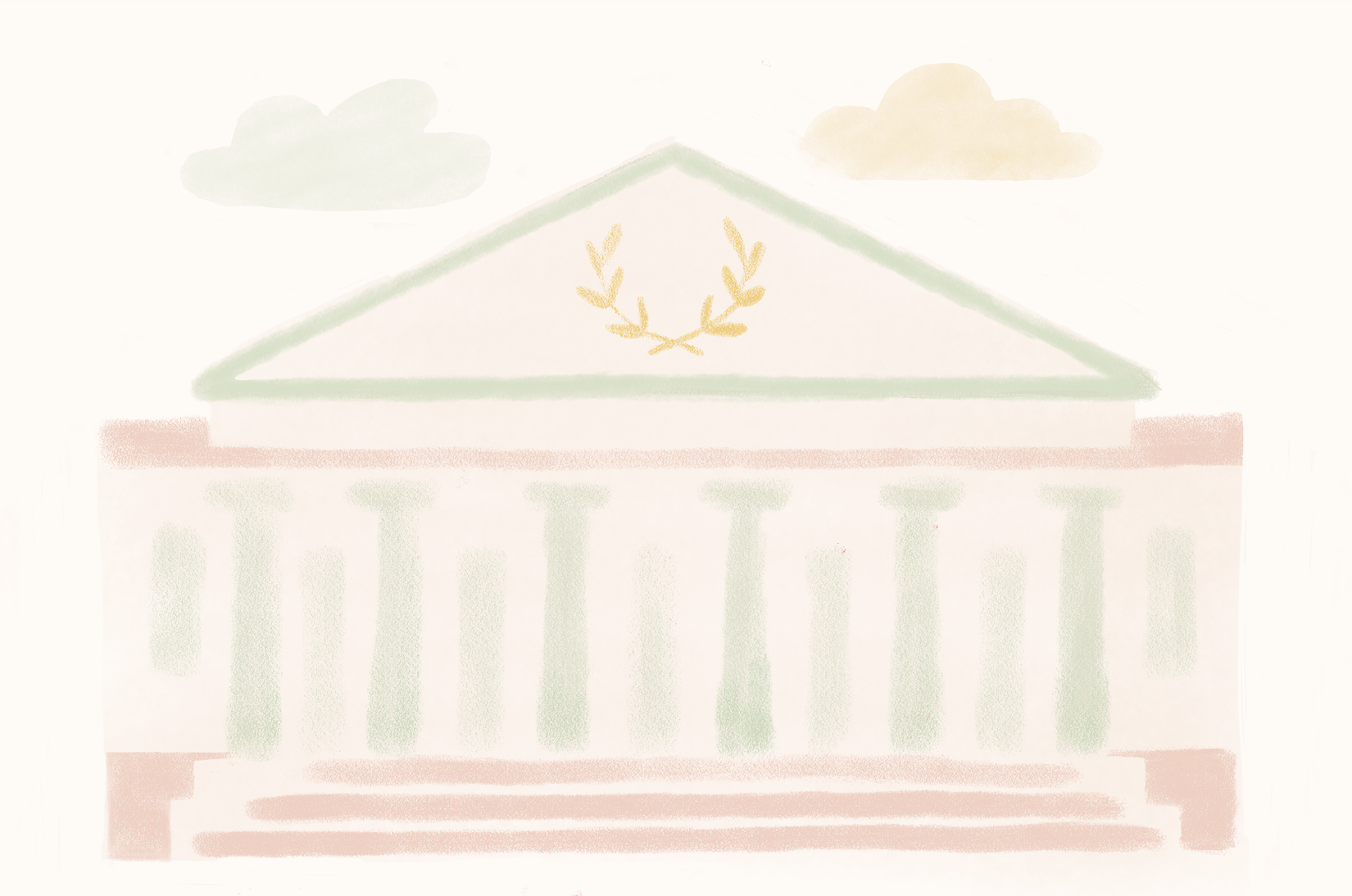
Stream the full guide on Spotify and Apple Podcasts.
© The Trustees of the British Museum
Lewis ChessmenTranscript
Let’s move over to the centre of Room 40. There’s a set of chess pieces here, made in the 12th century. They’re called the Lewis Chessmen, because they were discovered in 1831, on the beach of the Isle of Lewis, in Scotland. They were probably made in what’s now Norway, but who buried them by the sea — and why — is still a mystery. That’s part of what makes them feel so intriguing.
Chess itself began in ancient India, as a game called chaturanga, around the 6th century. It was a kind of war game, with pieces like chariots, elephants, and cavalry. The game spread through Persia and the Arab world, reaching southern Europe by the 8th century, and northern Europe by the 12th century. As chess travelled, people in each region changed it in their own way.
And when it arrived in medieval Europe, it was completely transformed. The piece names and roles were adapted to fit Christian society — so kings, queens, knights, and bishops all took their place on the chessboard. But the Lewis Chessmen are a bit different. They look like typical medieval chess pieces at first, but if you look closely, you’ll notice traces of Norse culture.
One piece stands out — the one we call the rook. Normally, it’s shaped like a castle or tower. But here, the rook appears as a warrior, holding a sword and biting down on his shield. This is a berserker, a Norse warrior.
The word comes from Old Norse — “ber” means bear, and “serker” means shirt — so it means “bear-shirt” or “bear-cloak.” These were warriors who wore bear skins into battle, and were said to fight with wild, animal-like fury. So instead of showing a tower or chariot, they made the rook into a living, raging warrior.
Why did they do that? Well, northern Europe adopted Christianity later than many other regions, and held onto its older traditions for longer. People often believed in both the Christian God and old Norse gods like Thor, side by side.
When new ideas came in, they didn’t just copy them — they absorbed them in their own way. Behind this was a strong oral tradition. For centuries, Norse myths and legends were passed down by word of mouth, and only began to be written down in the 12th century — right around the time these chess pieces were made.
It was a transitional time, when old Norse beliefs and new Christian culture were still blending together. So even in a foreign game like chess, the Norse people added familiar figures and stories to make the pieces feel their own. These chessmen reflect how they saw the world. And honestly, that’s still true today.
When people see familiar images or stories, it’s easier to understand, and easier to get drawn in. Think of modern video games — they often include things that feel local or familiar, so players can connect and enjoy them more. This berserker piece was the local version of chess for people in northern Europe — a version that made sense to them.
Astrolabe© The Trustees of the British Museum
Transcript
Let’s head into Room 42. This room’s full of objects from the Islamic world, made between the Middle Ages and later centuries. Have a look around — can you see a round, golden-coloured instrument with a ring at the top? That’s an astrolabe — or in Arabic, al-Asturlab. Think of it as a portable astronomical calculator. It can tell the time, track the stars, and even help you find direction.
On the front, there’s a flat circular plate with a delicate cut-out disk on top — that’s the star plate. On the back, you’ll notice a scale and a small rotating arm. Here’s how you tell the time with it: first, you hold the astrolabe by the ring so it hangs straight down. On the back, you use the arm to measure a star’s height above the horizon. Then you turn it over to the front. Rotate the star plate until the pointer for that star sits on the line that matches the height you’ve just measured. Once it matches, you can read the time from the scale around the edge.
Now, why are there several plates inside? Those are latitude plates, each made for a different part of the world. The sky looks different depending on where you are. Near the equator, stars pass almost straight overhead. Farther north, they move across the sky at an angle, and some stars never rise or set at all. Which means an astrolabe made for one place won’t work properly in another. Each latitude plate shows the pattern of the stars for its location. On top sits a rotating star plate — basically a star map you can turn to line up with the background plate. For example, Mecca, Cairo, and Istanbul each need their own latitude plate.
As the Islamic world expanded, more cities meant more plates. At first, three were enough. By the early 1600s, some had seven — and one of them is in this museum. These instruments weren’t only for scholars studying the stars. They were part of daily life. In cities, the muezzin — the person who called to prayer five times a day — used one to know when and where to pray. Each prayer had a set time, and all had to face Mecca. That need to get the time and the place right was what made instruments like the astrolabe so important.
Knowing the exact time and direction is also vital for navigation at sea. Later, the astrolabe spread to Europe and became an important tool in the Age of Exploration. You might even have seen it in fiction. In the fantasy novel His Dark Materials, the main character carries a magical golden compass — an idea inspired by the astrolabe. So in this one small handheld device, you have time, faith, science, and even a bit of adventure — all in one.
© The Trustees of the British Museum
Yaxchilán LintelTranscript
Let’s head into Room 27. Here, you’ll find objects from three ancient cultures that once thrived in what’s now Mexico — the Maya, the Mixtec, and the Aztec. These civilisations lived in different times and places, but they had something in common — they all used writing systems that looked like pictures.
In the 1500s, when Spanish forces invaded this region, many artefacts were destroyed, and most of their books and documents were lost. That’s why only a few examples survive today — and the writing itself is so complex, that for a long time, no one knew what it meant. To most people, it just looked like art. But in fact, it was a highly sophisticated system, with symbols that recorded both sounds and meanings. Then, in the 1960s, researchers realised that Maya writing was a real language, and from that point, their history started to come to life.
Do you see those five stone panels on the wall? They’re called the Yaxchilan lintels. The three on the left once stood above the doorways of royal buildings in the ancient Maya city of Yaxchilan. They show the king and queen taking part in a bloodletting ritual. These carvings are so detailed and precise that they’re considered masterpieces of Maya stone art.
And because the main figure is a woman, they’ve drawn special attention from scholars — especially since the 1980s, when more of the text began to be deciphered. Take a close look at the first panel on the left. The queen is kneeling in front of the king, who holds a torch. She’s pulling a cord through her tongue, and the cord has obsidian blades attached to it. The level of detail makes her pain feel almost real and immediate, even today. For the Maya, rituals like this — offering blood — were a way to communicate with the gods. You can see proof of that in the second panel, where the queen has a vision of an ancestor appearing in the form of a giant snake.
Now, look back at the first panel again — see the line of Maya glyphs across the top? The first two symbols give us a date — the year 709, in our calendar. Then it names the king, his title, and describes the ritual event. The queen’s name was Kabal Xook. You can see her name written in four glyphs, stacked vertically on the left.
The first glyph means “noblewoman”, the second is her family name, Kabal, and the third shows her personal name, Xook — the symbol looks like a shark’s head, because “Xook” means shark in Maya. So that symbol records a sound. The final glyph shows her royal title — “queen.” Thanks to these carvings, we know not just her name, but also the ritual she performed, and the pain and meaning it held. Even after more than a thousand years, her story is still here — written in stone.
© The Trustees of the British Museum
TAlly StickTranscript
Let’s go over to Room 1. Head a bit further inside, and look for Display Case 17. Inside, you’ll see four wooden sticks. Take a close look at the one on top — that’s a tally stick. It was used in England from the 12th to the 19th century as a tool for keeping financial records. The one here was made in the 1800s. Look at the right end of the stick — you’ll notice a series of notches cut into it. These marks were used to record amounts of money. By the number and spacing of the cuts, people could tell roughly how much was owed.
But here’s the really clever part. The stick was split lengthwise into two pieces, and each person kept one half. The short half went to the borrower, and the long half stayed with the lender. Later, when the debt was repaid, they’d bring the pieces back together. If the two halves matched perfectly, it proved the transaction had been completed properly. Because the grain of the wood matched, it was almost impossible to fake. No one could cheat the system. Even today, we still use the phrase “It tallies!”, meaning “it adds up” or “it checks out.” That comes from these tally sticks.
So this simple wooden stick acted as a contract or receipt, and it was used not just by ordinary people, but even by the British Treasury and the Bank of England. And this way of recording information goes back much further than you might think. One of the oldest known examples is the Ishango bone from Congo in Africa. It’s about 20,000 years old, and it has regular notches carved into it — possibly for counting or tracking dates. It might have been an early calculator or calendar.
So why did tally sticks disappear? Simple — they could only record amounts. As taxes and accounting became more complex, people needed more precise ways to keep records. That’s why tally sticks eventually faded out. What’s surprising is how long they lasted. Even after paper and printing were invented, the British government kept using tally sticks well into the early 1700s. They were physical proof — something you could see and touch, and even people who couldn’t read or write could use them — from common folks to nobles. Eventually, in 1826, tally sticks were officially abolished.
But at the very end, there was a disaster. On the 16th of October, 1834, a pile of old tally sticks was dumped into a fire in the basement of the Houses of Parliament in London. The fire got out of control, and the entire building burned down. So if you’re wondering why tally sticks disappeared — now you know for sure.
